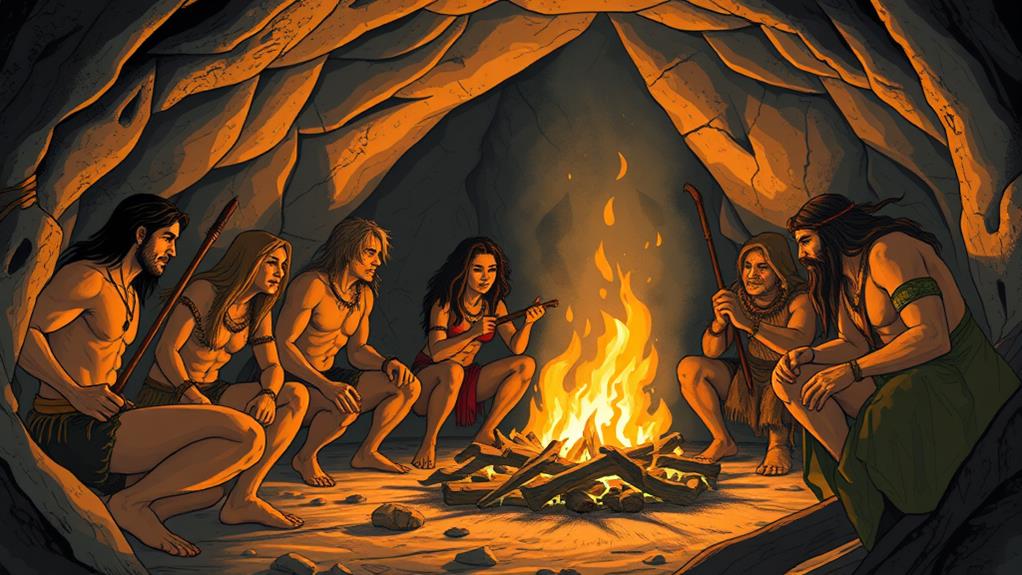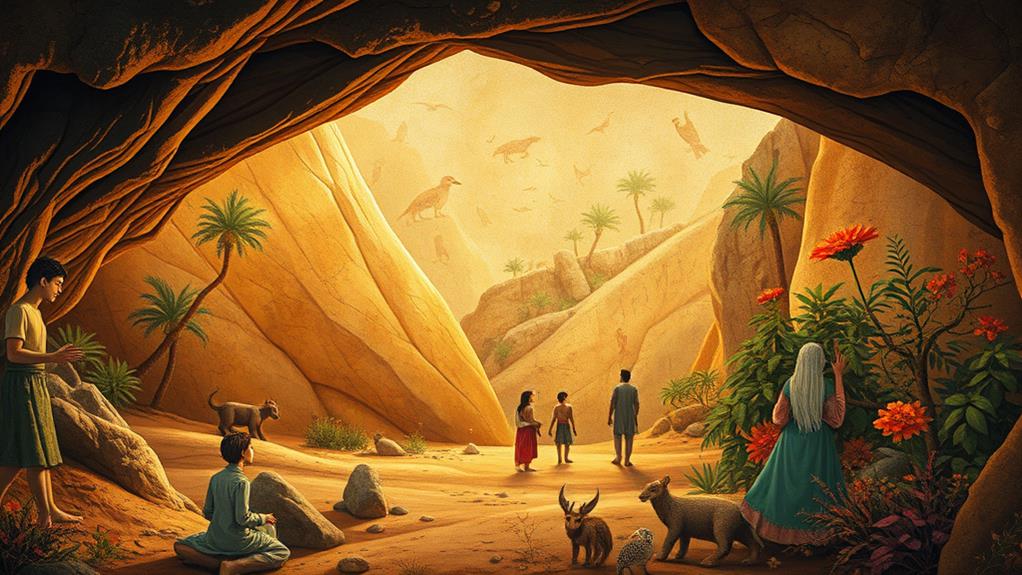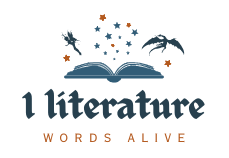When you explore prehistoric life in "The Clan of the Cave Bear," you encounter Ayla, a resilient Cro-Magnon girl overcoming immense challenges. The novel immerses you in themes of survival, adaptation, and gender dynamics within a Neanderthal clan. Ayla's journey showcases innovation versus tradition, emphasizing her struggle for identity and acceptance. Through rich descriptions and extensive research, the narrative brings the Ice Age to life, highlighting daily survival tactics and social structures. This vivid storytelling deepens your understanding of early human connections and societal complexities, prompting you to reflect on the broader implications of this fascinating era.
Overview of the Novel
Often regarded as a groundbreaking work, "The Clan of the Cave Bear" introduces you to Ayla, a young Cro-Magnon girl who faces unimaginable challenges after losing her family to an earthquake. Set in prehistoric times, this novel investigates the complexities of survival and adaptation as Ayla finds herself adopted by a clan of Neanderthals.
This narrative not only explores her personal journey but also reflects on themes of female empowerment and self-expression akin to those in stories like "Like Water for Chocolate." The narrative paints a vivid picture of her struggles to forge an identity within a culture vastly different from her own.
Key characters like Iza, the clan's compassionate medicine woman, and Creb, the shaman, play pivotal roles in Ayla's journey. As she learns the ways of the clan, readers witness her remarkable resilience in overcoming obstacles, including prejudice from Broud, the future leader who resents her presence.
Auel's meticulous research into prehistoric life enriches the storyline, making it a compelling exploration of human experiences during the Ice Age.
Through themes of love, identity, and cultural differences, "The Clan of the Cave Bear" provides a profound insight into the lives of early humans, drawing you into the intricate world of Earth's Children.
Main Character: Ayla
Ayla's journey is enthralling as you watch her grow from a vulnerable orphan into a valued member of the Neanderthal clan.
Her character exemplifies a strong female lead, embodying the themes of empowerment and resilience as she faces societal challenges.
Her struggles with clan dynamics, especially her conflicts with Broud, reveal the tension between her innovative spirit and the rigid traditions of her new family.
You'll find her personal growth and resilience truly inspiring as she navigates these complex relationships.
Ayla's Personal Growth
From a helpless five-year-old orphan to a respected member of the Neanderthal clan, Ayla's journey illustrates remarkable personal growth. You witness Ayla's resilience as she confronts prejudice from clan members, especially Broud, the leader's son. This negativity fuels her determination to prove her worth and find her identity within the clan.
Her bond with Iza, the clan's medicine woman, plays a significant role in her development. Iza teaches her the secrets of herbal medicine, nurturing her skills and confidence, which become essential assets in her journey.
Ayla's innovative problem-solving abilities set her apart from the clan's rigid traditions. While others cling to the ways of the past, you see Ayla embrace new ideas, showcasing her adaptability. This contrast ultimately leads to her acceptance among the clan members.
Struggles With Clan Dynamics
Maneuvering the complexities of clan dynamics proves challenging for Ayla as she grapples with her identity in a world that initially rejects her. As a Cro-Magnon girl adopted by a Neanderthal clan, she faces constant scrutiny due to her differences. Her journey is marked by pivotal relationships and conflicts that shape her experience.
- Iza, the compassionate medicine woman, becomes a beacon of support, helping Ayla navigate the clan's rigid social structure.
- Broud, the leader's son, often embodies male dominance, antagonizing her and highlighting the gender power struggles within the clan.
- Creb, the shaman, recognizes her unique abilities, allowing Ayla to slowly inch toward acceptance among clan members.
Ayla's innovative thinking often clashes with the clan's traditional ways, making her feel like an outsider. Through Iza's nurturing guidance and Creb's acknowledgment, she begins to carve out a place for herself.
Yet, the constant tension with Broud emphasizes the difficulties she faces in gaining full acceptance. Ultimately, Ayla's struggles with clan dynamics reflect a broader theme of resistance to change in prehistoric society.
Character Dynamics and Social Structure

Character dynamics and social structure in 'The Clan of the Cave Bear' create a rich tapestry of conflict and connection among the characters. Ayla, as a Cro-Magnon, faces the challenge of being an outsider in a Neanderthal clan, highlighting her struggle for acceptance. This theme of resilience and personal growth resonates with the narrative of overcoming societal challenges.
Iza, the clan's compassionate medicine woman, becomes a pivotal figure in helping Ayla adapt, teaching her about healing and the customs that govern their lives. This mentorship fosters a bond that contrasts with the rigid expectations of clan society.
Creb, the clan shaman, recognizes Ayla's unique abilities and serves as a bridge between tradition and innovation, advocating for her despite the clan's resistance.
Broud, the clan chief's son, embodies the male dominance and power struggles that permeate their social dynamics, often antagonizing Ayla and reinforcing strict gender roles.
The clan's deep reliance on established customs clashes with Ayla's innovative thinking, illustrating the tension between tradition and change.
Through these relationships, you see how social structures can both uplift and constrain individuals, revealing the complexities of belonging and identity in a prehistoric world.
Themes and Cultural Insights
In 'The Clan of the Cave Bear,' themes of identity and belonging are woven intricately into Ayla's journey as she grapples with her place in a Neanderthal clan. As a Cro-Magnon girl, she faces significant cultural differences that challenge her understanding of social norms, much like how generational poverty and resilience play an essential role in shaping characters' lives in *A Tree Grows in Brooklyn*.
Consider these key themes:
- Identity: Ayla's struggle to define herself amidst a clan that doesn't fully accept her.
- Belonging: Her desire to fit in while maneuvering the harsh realities of prehistoric life.
- Resilience: The strength she shows in adapting to the clan's strict gender roles.
The novel vividly portrays the brutality and beauty of Ice Age life, showcasing Ayla's personal growth in the face of adversity.
Auel's meticulous research guarantees an authentic representation of Neanderthal social structures, enhancing the reader's understanding of their daily lives.
Through Ayla, we witness the importance of innovation and adaptation, reflecting how resilience can lead to empowerment.
As you explore deeper into her story, you'll discover a rich tapestry of prehistoric culture that challenges conventional views on identity and belonging in a world defined by survival.
Communication and Cognitive Differences

In "The Clan of the Cave Bear," you'll notice how the Neanderthals rely on gestures for communication, highlighting their cognitive limitations compared to Ayla.
This reliance on non-verbal cues mirrors the struggles faced by many individuals in real life, where barriers in communication can stem from trauma and adversity, similar to the experiences shared by women in their survival stories.
Her innovative thinking not only sets her apart but also showcases the clan's struggle with rigidity and a lack of adaptability.
This contrast reveals deeper themes about social interaction and the barriers that can arise from different ways of communicating.
Neanderthal Communication Limitations
Neanderthals in "The Clan of the Cave Bear" face considerable communication limitations that shape their social interactions. Their restricted vocal range makes verbal communication difficult, leading to a reliance on gestures and visual cues. This reliance highlights the cognitive differences between Neanderthals and Cro-Magnon humans, particularly affecting how they perceive and respond to one another.
- Gestures become essential for conveying emotions and intentions.
- Misunderstandings frequently arise due to the lack of nuanced communication.
- Social tensions escalate, particularly surrounding Ayla's integration into the clan.
Ayla's innovative thinking and problem-solving skills starkly contrast with the clan's traditional methods, further complicating her acceptance. Characters like Creb, the shaman, show slight cognitive advancement, but overall, the clan's communication barriers often lead to friction.
As you explore these dynamics, it's clear that the limitations in Neanderthal communication considerably impact their social structure, relationships, and the acceptance of those who think differently, like Ayla. The narrative effectively illustrates how these barriers create a chasm between individuals, fostering an environment ripe for conflict and misunderstanding within the clan.
Ayla's Innovative Thinking
Often, Ayla's innovative thinking sets her apart from the Neanderthal clan, illuminating the stark contrasts in communication and cognitive abilities. While the Neanderthals cling to tradition, relying heavily on gestures and limited vocalization, Ayla adapts her communication style to bridge these gaps. Her understanding of context allows her to express ideas and emotions more effectively, fostering deeper connections within the clan.
Ayla's cognitive abilities, such as quick reasoning and creative problem-solving, showcase the evolutionary advantages of Cro-Magnon humans. For instance, her use of herbs for healing demonstrates her ability to think outside the box, contrasting sharply with the clan's rigid adherence to tradition. This difference creates conflict, driving character development as Ayla navigates her place within a society resistant to change.
The presence of Creb, the clan's shaman, adds complexity to the narrative. He's the only character with a sense of foresight, which highlights Ayla's unique perspective.
Throughout the story, her innovative thinking not only challenges the Neanderthals' limited worldview but also prompts readers to reflect on the importance of adaptability and creativity in overcoming obstacles.
Research and Realism in the Narrative
Authenticity permeates Jean M. Auel's "The Clan of the Cave Bear," showcasing her extensive research into prehistoric life. You'll find that Auel intricately weaves realism into her narrative, reflecting the complexities of Neanderthal culture. Her commitment to historical accuracy is evident in various aspects: the exploration of early human survival strategies echoes themes found in stories like Louis Zamperini's survival against extreme adversity in the triumph of the human spirit.
- Detailed descriptions of tool-making and cooking methods
- Insights into medicinal practices rooted in archaeological findings
- The slow-paced storytelling that mirrors the daily life and survival strategies of early humans
Auel's ability to blend factual elements with fictional storytelling enhances character development and enriches the plot. You'll appreciate how she incorporates archaeological insights while maintaining a vivid depiction of life in that era.
Through her careful attention to detail, Auel doesn't just tell a story; she immerses you in the world of Neanderthals, allowing you to grasp their struggles and triumphs. The balance she strikes between artistic license and realism guarantees that each scene resonates with authenticity, making the prehistoric world feel tangible.
As you read, you're not only entertained; you're also educated about the nuances of survival strategies and cultural practices that defined early human societies.
Adaptation in Film Interpretation

When you compare the film adaptation of "The Clan of the Cave Bear" to the novel, you'll notice significant differences in how Neanderthal society is portrayed.
While the film highlights cooperative survival, it sacrifices emotional depth and character complexity due to runtime constraints.
This mirrors the complexities found in adaptations like Richard Wright's *Native Son*, where themes of systemic racism are often diluted in film interpretations.
These choices shape your understanding of the story, leaving you to question the true nature of the characters' relationships.
Film Vs. Novel Differences
Numerous differences exist between the film adaptation of *The Clan of the Cave Bear* and Jean M. Auel's novel. While the film presents a visually engaging interpretation, it often sacrifices character development and emotional depth for runtime efficiency.
Here are some key differences to reflect on:
- The film emphasizes hunting scenes over gathering behaviors, neglecting the novel's balanced portrayal of daily life and survival strategies.
- Ayla's character, while positively portrayed, lacks the intricate growth depicted in the book, as pivotal moments are condensed or altered.
- Budget constraints lead to inferior special effects and costume design, overshadowing the rich world-building found in Auel's detailed narrative.
These adaptations create a swift narrative pace that disrupts emotional connections, prompting many viewers to revisit the novel for a more thorough experience.
The film may intrigue you visually, but it often simplifies the Neanderthal world, missing the complexity and nuances of relationships that the book so masterfully explores.
If you seek a deeper understanding of Ayla's journey and the intricacies of Neanderthal life, the novel remains the superior choice.
Portrayal of Neanderthal Society
The film adaptation of *The Clan of the Cave Bear* presents a nuanced interpretation of Neanderthal society, showcasing them as emotionally complex beings with social structures.
You'll notice that the film attempts to highlight the emotional depth and cultural life of these prehistoric people, challenging the typical stereotypes of brutishness. However, while hunting scenes depict their survival strategies effectively, the absence of gathering behaviors leaves a gap in understanding their subsistence methods.
The portrayal of Neanderthal society in the film emphasizes their interconnectedness and community dynamics, suggesting a rich tapestry of relationships.
Yet, budget constraints during production resulted in some clichéd representations, particularly regarding clothing and lifestyle, which mightn't accurately reflect archaeological findings.
You might find the music, with its guttural noises and drumbeats, enhances the primitive atmosphere, but it also risks reinforcing the stereotype of Neanderthals as uncivilized.
Despite these shortcomings, the film does succeed in presenting a more sophisticated view of Neanderthal society than many previous interpretations, allowing you to appreciate the complexities of their prehistoric life.
Controversial Themes and Content
Within the pages of "The Clan of the Cave Bear," readers encounter a raw and unflinching portrayal of prehistoric life, rife with controversial themes that can provoke intense reactions. The novel doesn't shy away from the darker aspects of humanity, challenging you to confront uncomfortable truths about societal structures in ancient times.
Much like Ta-Nehisi Coates in his exploration of systemic issues, Auel's narrative compels readers to reflect on the historical legacies of oppression that resonate through time, particularly regarding the complexities of racism in America.
Consider these contentious themes:
- Misogyny and strict gender roles: The narrative highlights the harsh realities faced by women, exposing the pervasive misogyny and domestic abuse prevalent in the clan.
- Sexual violence and child molestation: Disturbing instances within the story may leave you feeling unsettled, as they reflect the brutal nature of survival.
- Ritualistic drug use and cannibalism: These elements reveal the lengths to which people might go in dire circumstances, showcasing society's darker inclinations.
Additionally, animal abuse surfaces, further complicating the moral landscape.
Auel's exploration of these heavy themes urges you to reflect on the societal issues that have echoed through time, reminding you that human nature can be both fascinating and frightening.
Writing Style and Detail

Auel's writing style in "The Clan of the Cave Bear" draws you into a vivid prehistoric world through her heavy use of descriptive language. You'll find yourself immersed in the intricate details of the prehistoric setting, from the chill of the wind to the lush flora that surrounds the characters.
Her storytelling is rich with authenticity, exploring the complexities of Neanderthal culture, survival techniques, and even spiritual beliefs. This exploration of human connections and resilience in challenging environments resonates with themes of personal growth and overcoming obstacles, similar to insights found in growth mindset principles.
As you journey through the pages, Auel dedicates extensive sections to tool-making and cooking, showcasing her thorough research. This meticulous attention to detail enhances the world-building, making you feel as if you're part of the clan as they navigate their daily lives.
Although the depth of detail may initially seem overwhelming, you'll likely come to appreciate the thoughtfulness behind Auel's portrayal of early human interactions and societal structures.
The immersive experience Auel offers allows you to engage with the narrative fully, making the prehistoric world feel not just real, but alive. By combining descriptive language with a focus on Neanderthal culture, Auel crafts an unforgettable exploration of humanity's past that invites you to reflect on survival and connection.
Recommendations for Readers
For those fascinated by the intricate portrayal of prehistoric life, "The Clan of the Cave Bear" offers a compelling journey worth exploring. This novel immerses you in the struggle for survival and the complex societal dynamics of the Neanderthal and Cro-Magnon communities.
It's a rich tapestry of cultural identity that showcases the resilience of humanity, reminiscent of stories that highlight the survival and resilience found in historical narratives.
Here are a few reasons you shouldn't miss this book:
- Engaging Themes: Immerse yourself in the exploration of gender roles and the societal dynamics that shaped early human life.
- Meticulous Research: Appreciate the authenticity of the prehistoric backdrop, appealing to both casual readers and archaeology enthusiasts.
- Historical Fiction Delight: If you love historical fiction, this novel's detailed narrative will resonate with you.
"The Clan of the Cave Bear" is more than just a story; it's an insightful look into our ancestors' lives.
If you're seeking similar narratives, consider watching "Quest for Fire," which also captures the challenges faced by early humans.
Embrace this enthralling journey into prehistoric life, and you'll likely find yourself reflecting on the threads of survival that connect us all.
Conclusion
In exploring "The Clan of the Cave Bear," you'll uncover a rich tapestry of prehistoric life through Ayla's journey. You see how her resilience and adaptability shine, much like a smartphone in a world of flip phones—highlighting the struggle between tradition and innovation. The novel challenges you to reflect on human connection and survival amidst adversity. So, immerse yourself and let Ayla's story remind you of the timeless strength of the human spirit.



